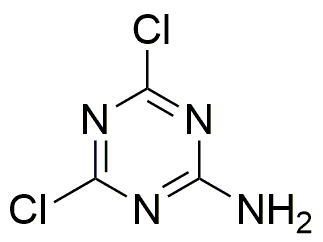4,6-Dichloro-1,3,5-triazin-2-amine is widely utilized in research focused on:
- Agricultural Chemistry: This compound serves as a key ingredient in herbicides, effectively controlling unwanted plant growth while minimizing damage to crops. Its selective action makes it valuable for sustainable farming practices.
- Water Treatment: It is employed in the formulation of water disinfectants, helping to eliminate harmful microorganisms. This application is crucial for ensuring safe drinking water and maintaining public health.
- Analytical Chemistry: Used as a reagent in various analytical methods, it aids in the detection and quantification of other chemical substances, thereby enhancing the accuracy of laboratory results.
- Pharmaceuticals: The compound is explored for its potential in drug development, particularly in creating new therapeutic agents. Its unique chemical structure can lead to innovative treatments for various diseases.
- Polymer Science: It is involved in the synthesis of specialty polymers, which are used in coatings and adhesives. These materials often exhibit superior durability and performance compared to traditional options.
General Information
Properties
Safety and Regulations
Applications
4,6-Dichloro-1,3,5-triazin-2-amine is widely utilized in research focused on:
- Agricultural Chemistry: This compound serves as a key ingredient in herbicides, effectively controlling unwanted plant growth while minimizing damage to crops. Its selective action makes it valuable for sustainable farming practices.
- Water Treatment: It is employed in the formulation of water disinfectants, helping to eliminate harmful microorganisms. This application is crucial for ensuring safe drinking water and maintaining public health.
- Analytical Chemistry: Used as a reagent in various analytical methods, it aids in the detection and quantification of other chemical substances, thereby enhancing the accuracy of laboratory results.
- Pharmaceuticals: The compound is explored for its potential in drug development, particularly in creating new therapeutic agents. Its unique chemical structure can lead to innovative treatments for various diseases.
- Polymer Science: It is involved in the synthesis of specialty polymers, which are used in coatings and adhesives. These materials often exhibit superior durability and performance compared to traditional options.
Documents
Safety Data Sheets (SDS)
The SDS provides comprehensive safety information on handling, storage, and disposal of the product.
Product Specification (PS)
The PS provides a comprehensive breakdown of the product’s properties, including chemical composition, physical state, purity, and storage requirements. It also details acceptable quality ranges and the product's intended applications.
Certificates of Analysis (COA)
Search for Certificates of Analysis (COA) by entering the products Lot Number. Lot and Batch Numbers can be found on a product’s label following the words ‘Lot’ or ‘Batch’.
*Catalog Number
*Lot Number
Certificates Of Origin (COO)
This COO confirms the country where the product was manufactured, and also details the materials and components used in it and whether it is derived from natural, synthetic, or other specific sources. This certificate may be required for customs, trade, and regulatory compliance.
*Catalog Number
*Lot Number
Safety Data Sheets (SDS)
The SDS provides comprehensive safety information on handling, storage, and disposal of the product.
DownloadProduct Specification (PS)
The PS provides a comprehensive breakdown of the product’s properties, including chemical composition, physical state, purity, and storage requirements. It also details acceptable quality ranges and the product's intended applications.
DownloadCertificates of Analysis (COA)
Search for Certificates of Analysis (COA) by entering the products Lot Number. Lot and Batch Numbers can be found on a product’s label following the words ‘Lot’ or ‘Batch’.
*Catalog Number
*Lot Number
Certificates Of Origin (COO)
This COO confirms the country where the product was manufactured, and also details the materials and components used in it and whether it is derived from natural, synthetic, or other specific sources. This certificate may be required for customs, trade, and regulatory compliance.


